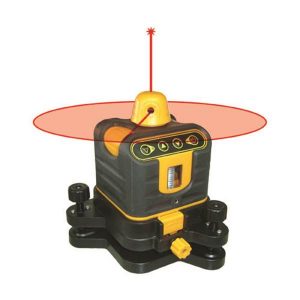The rotary one is the most useful tools for framing or foundations work. With a 360 reference level, it makes easy to building up or digging down in a level.
Between 3 types of laser, rotary laser level got the most extended coverage with greater accuracy. However, it would be stupid to compare them. So, let’s know how exactly to use a rotary laser level and what are the applications.
How Rotary Laser Levels Work?
The rotary laser level is nothing but a dot laser rotating in 360 degrees. No to mention, its the most advanced laser level present at this moment. Unlike line lasers which creates a fixed line illumination, the rotary laser levels create a horizontal plane illumination (just as chalk lines).

So, hows this possible?
The rotary laser spins the laser dot in 360 degrees horizontally with fast action. This creates a vertical or horizontal plane effect. Well, you can adjust the RPM(spinning speed) of the beam according to your work. The RPM varies between 100-1000 RPM.
The Leveling Mechanism
Next, the rotary laser level can be manually-leveling or self-leveling. With former, you need to adjust bubble vials for leveling. So it’s advisable not to disturb the tripod during measurement as it can lead to errors. The later uses pendulum and magnets for auto-leveling mechanism. While self-leveling rotary levels got a better accuracy, they’ve some threshold range beyond which they stop auto-leveling. The range is said to be 5% up or down.
In brief, if you want to save time, go for a self-leveling rotary laser level though nowadays most of the rotary levels come with a self-leveling option.
There is a new kind of leveling technique is being used by new generation rotary levels called electronic self-leveling. This mechanism uses small servo-motors to level itself.
The Color Mechanism
The rotary levels can come with red or green beams. The green beam rotary lasers have better visibility than the red one. If you want to know why? Read our red vs. green laser level article.
The Working Range
As mention above, rotary levels have the highest working range compared to other types of laser levels. Some rotary lasers can work up to 2000 ft. With the help of a detector. The working range is the radius as the rotary levels work in 360 direction. You can find the working range without a detector on the item specification. Basically, you can’t see the laser beam in a naked eye outside the working range.
Laser Level Calibration
Some levelers come pre-calibrated some not. The calibration is necessary to provide you the accurate measurement. Normally, once calibrated, the laser levels don’t need recalibration within next one year. However, this subject to your working conditions. If your rotary laser has ever fallen or got some hard knocks, you need to recalibrate.
Rotary Laser Level Applications:
Below I’ve mentioned the works where you can use rotary laser levels.
- Framing
- Foundations
- Acoustic Ceiling
- Window & Glass
- Excavation
- Grading
- Fences
- Slabs
- Trim Work
Let’s divide the applications to the interior or exterior works.
Interior Work:
For interior work, you can mount leveler in wall or ceilings. While working in indoor, you don’t need a laser detector; because the working range is small and laser beams are easily visible inside.
Exterior Work:
For exterior work, you need a tripod to mount. You need a laser detector attached to a grade rod to detect laser beams at a high range. The laser detectors increase the working range of rotary levels drastically. Pick the right laser color beam according to your outdoor work condition.
Got some ideas? Get a rotary laser level for yourself right now.